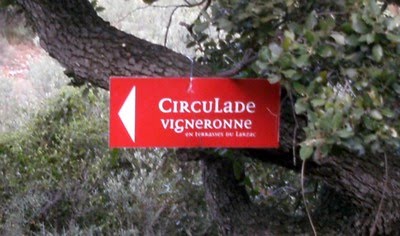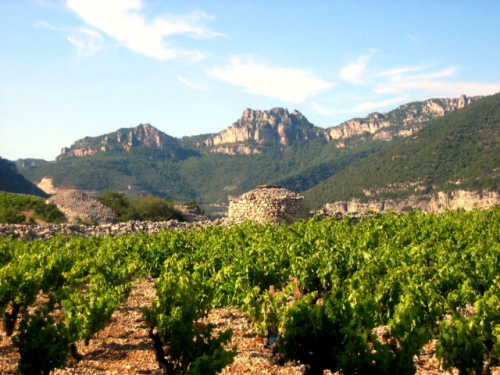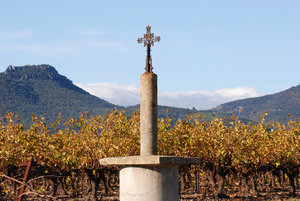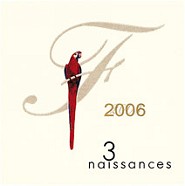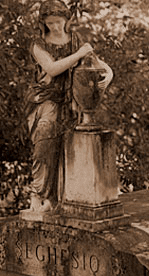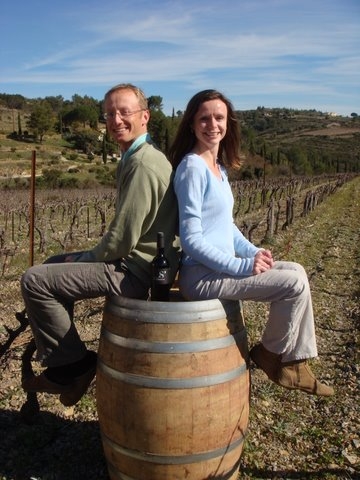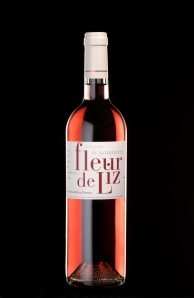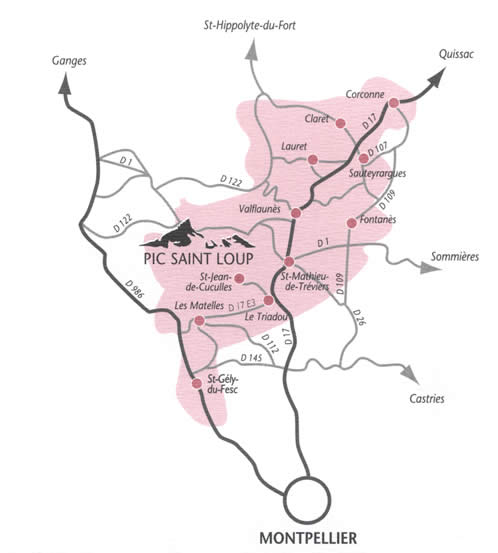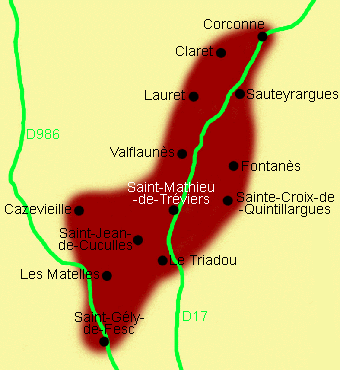The Terrasses du Larzac Circulade Vigneronne is now a regular fixture for the first Saturday in July but this year was our first attendance. St Jean de Fos, with its backdrop of Larzac foothills, was host village for this year’s bash. The organisation turned out to be exceptional – excellent signage, grass cut to cross fields, lollipop wardens at road crossings, handrails erected for the odd stony section, plenty of drinking water, tables and chairs laid out – the list goes on. To combat any food shortages due to greedy attendees a voucher for each course was needed. The format is to walk a kilometre or so to reach a pleasant spot such as an olive grove where a field kitchen backed by a number of vignerons await. Stay as long as you like and then move on. Over 40 (more than half) of the Terrasses du Languedoc producers were represented, the deal being they could only show one wine. That wine had to qualify for the AOC (now AOP or whatever) regulations, sad evidence that reform is needed urgently. Being well over 30°C and breezy it was more an occasion for overall wine impressions rather than definitive note taking. We started with a rosé from Domaine La Croix Chaptal 2009. Made “the old fashioned way” with much riper grapes than would be suitable for making red. The result is a nice chewy rosé with cool soupy fruits. Made a note to seek out and try a bottle. Of the four whites sampled the pleasant surprise was Château de la Devèze Monnier 2009 Blanc. Pointing out I’d never heard of the place, the explanation that 75% of production is sold at the cellar door accounted for the low profile, as did being sited beyond Ganges north of Pic St Loup. The vineyard grows a menagerie of varieties but this Roussanne and Marsanne blend is aromatic with a nice integrated citrus zip. Read More on: Languedoc Wineby: Graham Tigg
The event is seriously popular and only early departure slots available a couple of weeks out. Arriving at the departure gazebo at 16:40 we were issued with various essentials – nice hat, glass, menu and guide, pencil, cutlery, neck pouch and breathalyser kit. We’d heard stories that food had run out the previous year, so an early start seemed a good idea in that respect, but it wasn’t ideal for the chaleur.TWITTER.COM/LOCALFOODWINE
*LOCAL FOOD AND WINE*
FACEBOOK/LOCALFOODANDWINE
Saturday, July 31, 2010
Circulade Vigneronne
Sunday, July 25, 2010
Terrasses du Larzac
The appellation, Terrasses du Larzac, is the Languedoc’s “new El Dorado.”
“The aim of French AOC wine law is to lend a sensual print to rock, stone, slope, and sky,” – Andrew Jefford, The New France
Terrasses du Larzac is a relatively new appellation – AOC status since the 2004 harvest– in the Hérault region of Languedoc-Roussillon in Southern France. In this sense it is absolutely reflective of the Coteaux du Languedoc’s re-establishment of the quality and prestige of its region’s vineyards, winemakers and especially its wines.
The Domaine de la Sauvageonne’s 2006 ‘Les Ruffes’ wine was placed in the top 100 wines of 2008 in The Wine Spectator, the leading USA wine magazine. Not only a tribute to the Domaine and its Director, Gavin Crisfield, this is proof of the quality potential in the Terrasses du Larzac.
The Terrasses du Larzac is a V-shaped area spreading from the Pic Saint Baudile, its cliffs and benches, that graduates on downward to the point of the V towards Aniane and Lake Salagou. The area encompasses 32 communes (villages such as Saint Jean de la Blaquière, Puechabon, Lodève, St.-Jean-de-Fos…) and produces some 75,000 hectoliters of AOC Languedoc, and only 9000 hl of AOC Languedoc -Terrasses du Larzac, annually. While the highest points of the natural boundaries of the Terrasses du Larzac reach over 800m high, the only planted and permitted AOC zones are between 50m and 300m high on the foothills of the Causse.
Terroir
The distinguishing factors of the Terrasses du Larzac, in addition to its elevation relative to the rest of the low-lying Languedoc, are its soils and its cooler diurnal temperatures.
Soils: Schist, sandstone and sedimentary rock from the Primary epoch characterize this rocky, stubbly soil that French vines seem to feel most comfortable in, as well as soil from old alluvial terrasses and spreading talus washed down by water from the Quaternary epoch. Vestiges of the red, volcanic earth, “les ruffes,” – origins as yet unexplained – are found in the soils of vineyards as far apart as Aniane and St. Jean-de-la-Blaquière.
Climate: Day and night time temperatures can vary enormously, as much as 13°-14° Celsius during the summer months due to maritime influences (as opposed to 11° C at the coast). This coolness and fluctuation is also attributed to the fresh air sweeping down from the Causse.
Olives have long been planted in the area as well as vines, which date back some 2,000 years. Sheep graze on the garrigue – heather, juniper, lavendar, thyme, fennel – of the predominantly limestone plateau and mountainside whose milk is then curdled, cultivated, fermented in dark, damp caves to yield the delicious roquefort which pairs so heavenly with the wines that fall under this AOC Terrasses du Larzac appellation, designated only for reds.
Small Stone Shelters and Dry Stone Walls Everywhere
Local records from the XVI century show that inhabitants owned at least one patch of vines which were often planted amongst fruit trees, as well as olive and almond trees. The fruit was for consumption while the vines brought in cash. This is why still today you can find small stone shelters and walls all throughout these lands dating back to these times and even earlier.
Listed by Quebec Liquor Control Board
Domaine Croix Chaptal : the Cuvée Charles, which celebrates its tenth anniversary this year, has been listed by the Quebec liquor control board. Vigneron Charles-Walter Pacaud is thrilled to be the first to carry the Terrasses du Larzac colours in ‘la Belle Province’.
Wine Writers Have Taken Notice
It is no wonder, then, that the big names of those whose pens are employed by their devotion to wine, have recently, as in the past several months, taken notice of the region:
From London’s Financial Times, Jancis Robinson wrote on June 5, 2010:
“For wine consumers, especially those who like hand-crafted, highly individual wines that express the place where they were grown and are sensibly priced too, Languedoc-Roussillon is the perfect playground.
And Andrew Jefford had this to say on June 19th 2010 in the Financial Times Report:
“The notion that anyone might buy Languedoc wines as an investment would have seemed laughable until very recently”, He continues: “It seems plausible to me that the best sites of the Languedoc might, a few decades hence, produce red wines to challenge the best from Côte Rôtie, Cornas and Châteauneuf. The range of varieties which flourish there is identical, and Languedoc wine at its best combines perfumed enchantment (a northern Rhône trait) with palate breadth and texture (more typical of southern Rhône warmth).”
According to Vincent Goumard, President of the Terrasses du Larzac syndicat there are currently 45 individually owned cellars and 4 cooperatives or “caves cooperatives,” which produce wines under the guidelines that qualify for AOC Terrasses du Larzac designation.
Robert Parker’s updated Wine Buyer’s Guide no. 7 and David Schildknecht’s Wine Advocate includes in its Outstanding Category ten entries from the Languedoc, three of which are from the Terrasses du Larzac region, though not all producing under the AOC designation: Mas Jullien, who is credited with coining the term Terrasses du Larzac but who produces under Coteaux du Languedoc;
Olivier Jullien is a pioneer of the Languedoc. When he took over the family domaine in 1985, he was one of the only believers of the potential of the Terrasses du Larzac (large terraces on the edge of the Cevennes plateau) to produce great wines from the Midi. 25 years later, he controls over 18 hectares of unique vineyard sites, managed following the principles of Biodynamic winemaking. Read More Here
La Peira en Daimasela who has drummed up a bit of a cult following amongst his English compatriots in the motherland; and, Domaine de la Grange des Pères the area’s old venerable, whose vineyards are all in the Coteaux du Languedoc appellation but because he uses some Cabernet Sauvignon in his blends, his wines don’t carry that AOC label but rather the Vin de Pays label (V.d.P. de l’Hérault).
Domaine de Familongue produces their reds under the AOC Terrasses du Larzac designation in St. Andre’ de Sangonis. Their 3 Naissance ’07 (so named because of the three births of proprietor/winemakers Jean Luc and Martine’s three children) is a deep and bright crimson colored, flawlessly tannic red with light liquorice notes that should be chosen for subtly spiced red meat dishes.
For this wine they hand pick the grapes at optimum ripeness after sorting vine by vine, and by hand. No fertilizers or herbicides are used. It is then 100% barrel fermented, de-stemmed and crushed with a long (5 week) maceration. They use only new and second-fill barrels, entirely European oak, for this vintage. A wine to drink today and to keep for 5-10 years. It won the Gold Medal for the Grand Vin du Languedoc 2009. It also took a Bronze from Decanter and is listed in the 2010 Guide Hachette. Their label shows a parrot because they keep 30 of them on their property. They also cultivate 9 hectares of olives from which they produce absolutely divine olive oil. Both their wines and olive oils can be purchased at the winery or online.
For a listing of 30 + wineries in and around the village of Aniane, visit:www.salondesvinsdaniane.com
TWITTER.COM/LOCALFOODWINE
*LOCAL FOOD AND WINE*
FACEBOOK/LOCALFOODANDWINE
Saturday, July 24, 2010
Cuisine Concepts
New takes on common concepts: Lobster on the fly; Guest-cheffing; apple pie a la derriere; and Patty's Pizza takes its cue from Koji Bbq...

1. LE TROISIEME LIEU — Stealing a tradition from music and comedy clubs, Paris bar Le Troisième Lieu has declared Mondays as 'open kitchen nights': any aspiring chef can register to be the venue's cook for the evening. All meals cost EUR 12.
2. PUBLIC PIE — Dutch mobile kitchen Public Pie features ovens that are integrated into the outdoor benching that is provided for patrons, meaning customers get exactly what is promised by the company motto: 'Fresh apple pie with a hot butt'.
3. PATTY'S PIZZA — Santa Monica pizza maker Patty's has done away with its brick-and-mortar eatery altogether, and moved its retail operation entirely online. On top of that, customers can choose to have their gourmet pizzas delivered baked or par-baked, giving them the option of completing the process their own oven.
4. LOBSTER PUSHER — How to make a sandwich more exciting to consumers? The Lobster Pusher's answer is to make the act of buying one emulate a drug deal. Customers interested in The Merchandise—a lobster bun—must first become a member of a Facebook group. Orders for product are conducted by SMS, and handovers take place surreptitiously on street corners.
Thanks to: Food Inspiration
TWITTER.COM/LOCALFOODWINE
*LOCAL FOOD AND WINE*
FACEBOOK/LOCALFOODANDWINE
Wednesday, July 21, 2010
Boutargue, Mediterranean Caviar
This is an ancient delicacy originating from the Mediterranean Sea. It is made from compressed fish eggs, silver mullet roe, to be exact. The roe is cured and dried to perfection using sea salt and then embalmed in a wax coating to seal in its flavor and freshness.

It costs about $200 per kilo but since it is meant to be eaten as a flavor-packed appetizer, you can buy it in lesser quantities and still enjoy generous portions.
The boutargue itself varies in color from yellow to orange to a burnished brown, though with the wax encasing it first appears as an odorless, colorless sausage.
This is such an ancient dish that it dates back to the 6th Century B.C.E. when the Phoenicians imported it into Provence when they founded Marseille. Still, the Greeks, the Italians (Botarga in Italian) and the Egyptians dispute the origin of the "caviar" delicacy.

In Corsica, Boutargue is enjoyed during the Christmas season. In Italy, they like it shaved thin on their spaghetti. In the South of France, in Martigues near Marseille, where it is the traditional dish, it is relished in thin slices, drizzled with olive oil and lime, served with green olives and crackers and accompanied by Arak, Pernaud, chilled Vodka or Fig Liquor.
TWITTER.COM/LOCALFOODWINE
*LOCAL FOOD AND WINE*
FACEBOOK/LOCALFOODANDWINE
Tuesday, July 20, 2010
Factory Farming: Emily Deschanel Speaks Out
"Nights At The Round Table," is a new series discussing relevant current issues. In this episode, participant Emily Deschanel, a committed Vegan, speaks out about Factory Farming. Presented by Gotham City Films.
Can't See The Video? CLICK HERE
*LOCAL FOOD AND WINE*
TWITTER.COM/LOCALFOODWINE
FACEBOOK/LOCALFOODANDWINE
Seghesio Family Vineyards, Sonoma
Seghesio Family Vineyards, Sonoma County
The Seghesio Story begins in 1886 when Edoardo Seghesio departed his family’s vineyards in Piedmonte, Italy for a new life in America. Like so many immigrants, he was drawn to Northern Sonoma County and the Italian Swiss Colony, to follow his passion for winemaking.
Because Zinfandel was the first vine that Edoardo planted, the Seghesios maintain their commitment to the varietal they are most known for. The Sonoma Zinfandel and the Cortina Zinfandel is full of complex, concentrated berries. From their Home Ranch and San Lorenzo vineyards, Seghesio also produces single-vineyard zinfandels. The Old Vines Zinfandel is made from the three single vineyard sites. Seghesio also produces two Italian white varietals from their Keyhole Ranch estate in the Russian River Valley, an Arneis and a Pinot Grigio.
Angela Vasconi and Edoardo were married in 1893. In 1895, they purchased a modest home in northern Alexander Valley, less for the home than the surrounding 56 acres Edoardo recognized as ideal vineyard land. They planted the “Home Ranch” that year to what has become our family’s lifeline – Zinfandel.
Edoardo remained at the Colony while building his own winery in the evenings after work. Upon its completion in 1902, the young couple began Seghesio Winery while raising their five children.
Seghesio produced jug wine before and after Prohibition, and produced wine for other wineries from World War II until 1983. They began producing wines under their own label, which ended up being mostly mediocre Cabernet Sauvignon and Chardonnay. Then, in the early 1990s, the IRS knocked on their door and delivered a $4 million bill for back taxes, forcing the Seghesios to make some difficult decisions.
After a considerable amount of soul searching, the Seghesios realized they were building a brand that simply wasn’t sustainable. Pete Jr. reflected, “Ted and I were tired of making cheap wine. But, we had a tough time getting the older generation to believe in us. They produced jug wine their entire lives – it’s all they knew. Then one day Uncle Ed said, ‘We're going to be the Jordan of Zinfandels,’ and I knew that he got it.
By 1993, the Seghesio brand had grown to 130,000 cases of not only the family’s zinfandel and Italian varietals, but also Chardonnay, Cabernet, Sauvignon Blanc and both red and white table wine. It was in that year that control of the winery shifted to the younger generation. They turned their focus to the vineyards and eliminated all but the wines they grow reducing production to 30,000 cases.
Today, they are proud to passionately produce almost exclusively estate wines, some from those same vineyards Edoardo and Angela first planted in the late 1800s.
*LOCAL FOOD AND WINE*
TWITTER.COM/LOCALFOODWINE
FACEBOOK/LOCALFOODANDWINE
Sunday, July 18, 2010
Picpoul de Pinet
Picpoul de Pinet

Picpoul-de-Pinet, cultivated on the French coast of the Mediterranean Sea, pairs perfectly with fresh, chilled oysters, prawns and other seafood.
Picpoul de Pinet, also spelled Piquepoul de Pinet, is both a rare white French grape varietal that thrives in the South of France and it is a designated appellation with its own A.O.C. classification in an area that hugs the Thau Lagoon between Sete and Agde in the Languedoc-Roussillon region of Southern France.
This fresh, crisp wine that splashes hints of lime and green apple in the mouth pairs beautifully with seafoods. It accents especially well the oysters and fresh prawns that grow in abundance off this Languedoc coastal region and the Thau Lagoon where the sun-loving, late-blooming grape thrives and where it enjoys its own Languedocian regional appellation.
A Great Future For A Little Known Grape
Piquepoul, the grape varietal, is used to make the light acidic wine called Picpoul de Pinet, with floral and citrus fruit aromas. It follows then, that the AOC Coteaux du Languedoc, Picpoul de Pinet classification, applies only to white wines.
This rare, ancient French grape thrives in the coastal sands near Sète in the Languedoc, the fishing village that affronts the Mediterranean Sea. The refreshing acidity of this full-bodied wine pairs especially well with seafood because of its more floral, citrus and peach flavors than the minerality of a Sancerre . Picpoul is mostly enjoyed by Languedociens or tourists visiting the area, at present, and is not yet exported as much as say, another rare French varietal, Viognier.
This clear, light-gold wine breathes appetizing aromas of peaches, juicy and fresh, with a back note of lemon-lime. Crisp and tart, white-fruit flavors and lemon-squirt acidity are fresh and cleansing in a very long finish. Not overly complex but bright and appealing, it’s a first-rate seafood wine. It has been called the Muscadet of the south of France. It is the wine that is usually served with oysters that can be found along the coasts of the Languedoc.
Serve very cool between 6 and 8°C to accompany all seafood,
Picpoul de Pinet A.O.C.
![]() The AOC Picpoul de Pinet vineyards cover some 1300 hectares (3000 acres) around the Thau lagoon to the west of the Mediterranean Golfe de Lyon.
The AOC Picpoul de Pinet vineyards cover some 1300 hectares (3000 acres) around the Thau lagoon to the west of the Mediterranean Golfe de Lyon.
It forms a triangle bounded by Agde, Pézenas and Sète. It is the largest white wine producer in the Languedoc.
The white Piquepoul grape inclines to ripen late, so the warm, humid sea breezes help it mature in good conditions.
| The climate |
| The weather pattern is typically Mediterranean with low rainfall (600mm or 24 ins) and moderate winters. Summers are dry. The maritime influence is influential in that it limits strong temperature variations : *Local Food And Wine*Twitter.com/localfoodwineFaceBook/LocalFoodAndWine |
Wednesday, July 14, 2010
La Fête des Rosés & des Blancs
La Fête des Rosés & des Blancs
Two prevailing characteristics of the Languedoc-Roussillon are that the region is steeped in history, specifically wine history, and it is known for its ripe, red wines.
But this once again up-and-coming wine region is taking its future in its own hands by using innovative approaches to freshen up its image. One of those approaches is to celebrate its vineyards' white and rose' wines.
In June and then again in November, the wineries of the region are encouraged to throw open their doors to tasters and wine buyers to especially highlight their rose' and white vintages.
Back in the region's heyday, during the XVII c., wines of the Midi, particularly its Muscats, and especially its Muscats secs, rivalled the wines of Burgundy. Wines from St. Georges d'Orques, a village where wineries still operate today, were known from border to border throughout France.
On a tasting of the Greater Languedoc region, these are some wines you ought to get the chance to try:
Cave de Roque Brun, St. Chinian. They are in the Guide Hachette and have won a Gold Medal in Paris's Concours Generale Agricole.
Domaines de Gallieres, a new vineyard that presented its "Salsa de la Vigne" at this year's tasting festival, a light-hearted rose' that pairs well with melon, prosciutto, feta wrapped in marinated red peppers.
Domaine Pibarot in Mus who handpicks their grapes and uses no pesticides.
Domaine du Silene. Legend has it that an effigy of Silenus, the tutor to Dionysius the Greek God of wine and the grape, was found on the premises and watches over the estate. Vineyards thrive in the exceptional clay and limestone soils.
Domaine de Montnegre whose Rose' is under the AOC Coteaux du Languedoc and made by blending Syrah, Grenache, Cinsault. Fresh and aromatic, it pairs well with light repasts. Their white, a blend of old Carignan blanc and Ugni blanc, is vin de Pays.
Le Domaine Puech, in Saint-Clement-de-Riviere, is a local favorite. Their Vin de Pays d'Oc Chardonnay with a floral, vanilla nose and a well-balanced, ample mouth.
Les Chemins de Carabote has a Terrasses du Larzac which exhibits both strength and elegance, richness and complexity. Featured in Guide Hachette.
Les Vignerons du Pic offers their "Gres de Montpellier," which is their wine that's on the map.
The AOC Gres de Montpellier was obtained in 2003 and encompasses most of the villages that are situated in the "Agglomeration" Montpellier. With this classification, the vineyards of the region are re-exerting and re-establishing their importance in the national culture of wine.
Domaine Jordy, which can be found in Le Bosc, keeps 500 hectares of vineyards under cultivation amidst 2500 hectares of garrigue, the native Mediterranean scrub brush thought to lend its aromatics of thyme, rosemary, lavendar to the wines. To keep with their whites and rose's try the Cers Vent, Viognier and Rose' cuvee' speciale, as well as their Blanc vendanges passerillees for a dessert wine.
*Local Food And Wine*
FaceBook/LocalFoodAndWine
Tuesday, July 13, 2010
2004 Château La Bienfaisance 'Sanctus' Saint-Emilion Grand Cru
By: The Wine Spies
 (http://thewinespies.com)
(http://thewinespies.com)
Mission Codename: Holy Vines
Operative: Agent White
Objective: Secure a delicious and exclusive Saint-Émilion Grand Cru Bordeaux for our operatives.
Mission Status: Accomplished!
Current Winery: Château La Bienfaisance
Wine Subject: 2004 ‘Sanctus’ Saint-Émilion Grand Cru
Winemaker: Didr Peytour
Backgrounder: The movie Sideways may have tried to kill Merlot, but real wine lovers know that the joke is on the character Miles. He boldly proclaims: ”If anyone orders Merlot, I’m leaving. I am NOT drinking any [censored] Merlot!”, Really, and his favorite wine is Chateau Cheval Blanc? Chateau Cheval Blanc, like today’s selection from Château La Bienfaisance is a Saint-Émilion, a Merlot and Cabernet Franc blend. (For those not lucky enough to have enjoyed a Cheval Blanc, it is about 60% Cab Franc 37% Merlot and the remainder other varietals)
Fellow Wine Spies know that the wines from Saint-Émilion Grand Cru have been treasured since the times that the Romans initially cultivated Bordeaux’s vineyards of the Rive Droite. Each Grand Cru vineyard has its own varietal composition and this selection is 70% Merlot and 30% Cabernet Franc, and is heavily influenced by the region’s famed Terroir of Graves and ancient sand.
Wine Spies Tasting Profile:
Look – Dense garnet and purple with a barely clear core that is nearly inky in character. Along the edges, the color shows ruby red highlights and when swirled fast thin evenly spaced legs ring the glass.
Smell – Well developed and balanced aromas of dark fruit including black cherry and blackberry are layered over sweet vanilla oak notes, smokey spice, hints of black licorice and earthy undertones.
Feel – Smooth and dry, this supple full-bodied wine is classic ‘right-bank’ in character with finely textured tannins that are supported by its lively but balanced acidity and Terrior driven minerality.
Taste – Classically old-world with reserved flavors of blackberry, cassis and black cherry meld perfectly with sweet oak flavors, spice and cigar tobacco. The licorice, herbal and earthy aromas found on the nose also make an appearance on the palate and add complexity to this lovely mature wine.
Finish – Medium long in length with this wine’s restrained fruit fading away softly as the classic supple and fine textured structure lingers on.
Conclusion – The 2004 Château La Bienfaisance ’ Sanctus’ Saint-Emilion Grand Cru is a delicious example of with the right bank still rules with lovers of Merlot and Cabernet Franc. Exceptional balance, great old world complexity and finesse, a lovely wine that will continue to age well for the next 5 to 10 years, perhaps longer!
Mission Report:
Château La Bienfaisance winemaker Didr Peytour is very busy and was quite hard to catch, we did get a brief opportunity to ask him a few questions and below is a transcript of our conversation.
WINEMAKER INTERVIEW
SUBJECT: Didr Peytour
AGENT WHITE: Bonjour Didr, We are thrilled to be showing your 2004 ‘Sanctus’ Saint-Émilion Grand Cru today. Thanks so much for taking some time to answer questions for our Operatives today.
DIDR: You’re welcome – I’m excited to have our 2004 Sanctus, our flagship wine featured on The Wine Spies.
WHITE: What is your background in wine or grapes?
DIDR: I have a higher technician certificate in Viticulture and Enology.
WHITE: Is there a specific experience in your life that inspired your love of wine?
DIDR: I’ve loved wine since my childhood.
WHITE: How long have you been making wine?
DIDR: I’ve been making wine for 23 years.
WHITE: What is your philosophy of winemaking?
DIDR: The gentle extraction of tannins to reveal the wine’s true character.
WHITE: What is your favorite grape variety?
DIDR: I love Cabernet Franc, one of the two varietals represented in this delicious wine.
WHITE: Please tell me a little bit about the wine we are featuring today.
DIDR: It’s a wine that is fully characteristic of the region. Its rich and opulent but has good acidity due to the moderating influence of ocean climate in Bordeaux. WHITE: In your opinion, what makes your ‘Sanctus’ so special?
DIDR: The Terroir of Saint-Émilion is among the best in France
WHITE: What is occupying your time at the winery these days?
DIDR: We are currently working on the 2009 vintage.
WHITE: Thank you so much for your time. We learned a lot about you – and your wine. Keep up the great work, we are big fans!
Wine Spies Vineyard Check:
The location of Saint-Émilion along the rive droite of the Dordogne (and the Gironde) can be seen in this satellite photo.
Twitter.com/localfoodwine
*Local Food And Wine *
FaceBook/LocalFoodAndWine
Saturday, July 10, 2010
You Say Tomato, We Say Tomato!
It's hard to imagine that anyone could know tomatoes better than the Tomatologue knows tomatoes. This is a tomato devotee who not only grows about 1200 different varieties of tomatoes, but someone whose eyes light up as he gingerly hands you the freshly cut slice of tomato from one of his artisanal varietals and watches as the delight sweeps across your face, dancing in harmony with the sensorially exquisite taste of the tomato in all its fullness of flavor as it bursts from the fruit and splashes over your tastebuds.
Words cannot describe the beauty of these tomatoes. So we will let pictures from the Tomatologue site do all the talking...
 Chocolate Tomato
Chocolate Tomato Ester Hesse Yellow Tomato
Ester Hesse Yellow Tomato Merveille Blanche
Merveille Blanche Teton de Venus
Teton de VenusTwitter.com/localfoodwine
*Local Food And Wine*
FaceBook/LocalFoodAndWine
Thursday, July 8, 2010
Domaine de Saumarez
Living The Dream In The Languedoc
Robin and Liz Williamson are enviable people. Both hail from other parts of the planet, Liz from New Zealand and Robin from the UK, but they've planted their home, and wine business, amidst the vineyards of the Midi.
Just outside Murviel-les-Montpelliers, and not too far from St. Georges D'Orques, both villages in the heart of the Languedoc-Roussillon in Sud de France, perches Domaine de Saumarez on a pretty hillside whose sweeping views take in the Mediterranean Sea in the not-too-distant yonder.
In 2006, the winery's top cuvee', their “Aalenien, '04” earned a full-bodied 92 points from Wine Spectator (Kim Marcus, 2006). “2009 is going to be another spectacular vintage,” says Williamson. Indeed, there's not a soul in France today who isn't singing the praises of the 2009 vintage year. As for 2010, “It was a hard winter but the vines seem to be quite happy now,” he says.
It was nearly a decade ago when Liz and Robin decided to shuck everything – him his banking career, her, accounting – and pursue their passion of wine. After repeated and extended wine tasting trips throughout the world and France, they settled on looking for a vineyard to call home in the region between the Spanish border and Nimes. This region, the “Midi,” or Languedoc-Roussillon, is the hub of wine making in France. It's not its most celebrated, but it is its most voluminous.
“We looked at 30 domains from the Spanish border all the way to Nimes. This was number 30,” recounts the Williamsons who are raising their two young sons up on the vineyard. “The winery had potential, even though it was a wreck,” reminisces Robin, pointing out that there was no roof on what is now the cellar and tasting room when they bought the estate back in 2003. By 2004 they had produced their first vintage. They sold their first bottles in 2006.
“Aalenien,” is not just the name of Domaine de Saumarez's top cuvee', it is also the name of the type of soil to be found on the property. The rocky soils are made up of Jurassic limestone that have bands of quartz running through them. This soil, found in about a 10 sq. km radius, is particular to Murviel-les-Montpellier, the 2,500 year old Roman-Gallo village that the Domaine is situated in. At its height, Murviel had 15,000 inhabitants and was one of the main towns on the ancient route traveled between Spain and Italy.
The soil makes for minimal weed growth, hence little need for pesticides nor weed killers; it is good with heavy rains because the rocky limestone is very porous yet it retains moisture at about 1 to 2 meters below the soil surface, thus keeping the vines hydrated. The region's 300 days of sunshine per year and tendency to get high winds dries out the vines.
The Languedoc region is also known for having numerous organically farmed vineyards and in fact the region as a whole is becoming specialized in organic. It has some of the highest concentrations of organic agriculture, and viticulture, in all of France. Domaine de Saumarez is no different and will be certified organic by 2012.
Robin Williamson is the type of vintner who likes to know what he's talking about. And he does. Before he and wife Liz bought the farm, he spent two years taking courses in oenology in Brighton. He finished his studies at the level just one shy of Master in Oenology. He'll gleefully talk to you about stirring the lees - “batonage” - and discuss with you the merits of using food-grade fiberglass fermentation tanks and square concrete ones for the reds and why they use mostly French oak barrels with only two American oak barrels thrown in the mix...But mostly he'll tell you, “We're farmers you know, no more or less, than farmers.”
He characterizes this as an “Old World” approach to winemaking. “In France the vigneron is still more Old World. We do it all. We're farmers. We're winemakers. We're wine sellers.” He concedes that as a grape farmer and winemaker you need to remain philosophical about certain things, like the weather. “You have to always stay on the front foot,” he says, reverting to a cricket-ism.
Domaine de Saumarez makes four wines. Their top cuvee' the Aalenien, a red. Notes of herbs, spices, minerals, olives and flowers. Their Domaine S' red – supple, ripe, lush with a spicy edge - and their Domaine S' white, - minerality and class, grapefruit, lemon peel that leads into a creamy width - all Coteaux du Languedoc AOC and a rose', the Fleur de Liz, also AOC, vins de Pays de l'Herault. As a red wine with the Coteaux du Languedoc AOC classification, it will have some or all of only these varietals: Grenache, Syrah, Mourvedre, Carignan, and Cinsault.
*Local Food And Wine*
FaceBook/LocalFoodAndWine
Argentina Trapiche Malbec - Goooaaallll!
Trapiche Malbec Single Vineyard wines keep amazing palates. Two of the most prestigiousinternational wine magazines, Wine Spectator from the United States and The World of Fine Wine from the UK have recently published an article in which our successful Single Vineyard wines are quoted.
Wine Spectator titled the article: Daniel Pi builds a track Record. In the picture he appears next to James Molesworth, Senior Editor of the magazine and the
responsible for tasting the wines from Argentina.
The prestigious wine critic made a vertical tasting of Trapiche Malbec Single Vineyard and these were his scores:
Trapiche Malbec Single Vineyard Viña Adolfo Ahumada 2007 I 91 points
Trapiche Malbec Single Vineyard Viña Domingo F. Sarmiento 2007 I 92 points
Trapiche Malbec Single Vineyard Viña Fausto Orellana de Escobar 2007 I 93 points
Trapiche Malbec Single Vineyard Viña Cristina y Bibiana Coletto 2006 I 91points
Trapiche Malbec Single Vineyard Viña Adriana Venturín 2006 I 92 points
Trapiche Malbec Single Vineyard Viña Federico Villafañe 2006 I 91 points
Trapiche Malbec Single Vineyard Viña Francisco Olivé 2005 I 91 points
Trapiche Malbec Single Vineyard Viña Eleodoro Aciar 2005 I 91 points
Trapiche Malbec Single Vineyard Viña Fausto Orellana 2005 I 92 points
Trapiche Malbec Single Vineyard Viña Carlos Gei Berra 2004 I 90 points
Trapiche Malbec Single Vineyard Viña Victorio Coletto 2004 I 90 points
Trapiche Malbec Single Vineyard Viña Pedro González 2004 I 90 points
Trapiche Malbec Single Vineyard Viña José Blanco 2003 I 90 points
On the other hand, three of the most prestigious wine critics from the UK and
collaborators for The World of Fine Wine* magazine: Tim Atkin MW, Gerard Basset and Anthony Rose, devoted a full article to Malbec from Argentina versus Malbec from Cahors.
They did a blind tasting of 40 Malbecs, 21 from Cahors and 9 from Argentina, among which our Trapiche Malbec Single Vineyard 2007 Viña Domingo F. Sarmiento, Viña Fausto Orellana de Escobar and Viña Adolfo Ahumada were rated with excellent scores.
The journalists agreed that Malbec is capable to offer a greater range of styles in
Argentina than in Cahors, mainly because of the differences in latitude and altitude.
Following please find scores:
Trapiche Malbec Single Vineyard 2007 Viña Sarmiento: 17.5
Trapiche Malbec Single Vineyard 2007 Viña Orellana: 16.5
Trapiche Malbec Single Vineyard 2007 Viña Ahumada: 15.5
*The World of Fine Wine is one of the most prestigious and professional wine magazines in the UK. Fine Wine uses a very professional punctuation system: blind and open tastings are at the center of the magazine. They use a distinctive and rigorous tasting protocol, which makes their tastings an impartial and invaluable guide to the world’s finest wines. 20-point scale, calibrated specifically for fine wine, strikes the best balance for our purpose.
*Local Food And Wine*
FaceBook/LocalFoodAndWine
Monday, July 5, 2010
Pic Saint-Loup
Pic Saint-Loup, Languedoc-Roussillon
Pic Saint-Loup in Côteaux du Languedoc produces some of the finest wines in the Midi. As a sub-appellation of the Languedoc AOC, it is petitioning vigorously, and successfully, to become its own appellation. Many foresee that it soon will succeed in these efforts.
“The vignerons of the Pic Saint-Loup have been very smart to identify their appellation with the majestic mountain of Pic St. Loup,” comments a compatriot winemaker from the Murviel-les-Montpellier sub-appellation just to the south of Pic Saint-Loup.
The Coteaux du Languedoc appellation was replaced by the appellation Languedoc AOC in 2007, but the two names will run concurrently until 2012.
The majestic peak of the St. Loup mountain is a dominantly identifying landmark for this notable region in Sud de France and it conveys the inextricably linked mark of the terroir, that of its cooler elevated vineyards which are set apart from the lower, and hotter, Languedocien plains.

The Pic Saint Loup and Hortus mountains are at the cross-roads of Legend and History. According to a children’s story, they were born from the blow of a club given by a giant who had flown into a terrible rage. Since then the mountain weeps from the Mascla spring. Pic Saint Loup also evokes the name of the sainted knight Loup who, in memory of his lady, became a hermit, singing his undying love from the top of this rocky peak…This is a land of vines and olive trees, crossed by shepherds and coal makers of every origin supplying the cities on the sea shore with wool and charcoal…
READ the complete Myth And Legend of Pic Saint Loup Wine Region on Domaine de l’Hortus
Thirty kilometers from the southern French coast, the climate is Mediterranean with the characteristic aromatic haut garrigue perfuming the terrain. The topography of the area, dominated by these two distinctive mountain peaks – Montagne de l’Hortus and Pic St. Loup itself – to the north and east means increased diurnal temperature variation which is an essential factor in the development of balanced acids and sugars in the wine grapes.
The Pic St. Loup is only red and roses. White varietals are grown in the appellation but are not bottled under the Pic Saint Loup AOC classification. Only reds are honored with that with the whites receiving a Coteaux du Languedoc, or the local Vin de Pays du Val de Montferrand also for the roses.
In fact they wineries have been quite strict in setting up their qualifications for the sub-appellation AOC:
The principal grapes must be Grenache, Mourvedre and Syrah; a vintage must contain at least two and must comprise at least 90% of the blend. At least 20% of that must be Syrah, a vine that is not indigenous to the area, but was planted early last century, along with Mourvedre and Grenache, as cépages améliorateurs, during the re-planting of the country’s vines. Maximum yield is 45 hl/ha, minimum alcohol is 11.5% and the vines must be at least 5 years old. These conditions will only become steeper when the INAO accepts their petition for AOC classification. Other varieties in the blend can be Carignan and Cinsault which are allowed a maximum of 10%.
The mesoclimates of this limestone dominated terroir allow for the viticulturists to plant the heat-loving Mourvedre in the warmer, lower vineyards and use the higher vineyards to grow a more elegant style of Syrah, which responds well to the cool mountain nights.
- Size: 13 villages north of Montpellier, stretching 25 km north–south and 10 km east–west
- Area of production: 1500 hectares, with 800 ha planted to Grenache, Syrah and Mourvèdre
- Producers: 3 caves co-op, 36 (and counting) individual producers
Lascaux is French for limestone rock, and Jean-Benoît Cavalier has 35 hectares of vines on a series of stony terraces located just north of the village of Vacquires. He took over from his father in 1984 and is now one of the leading growers in the appellation. His best wine, Les Nobles Pierres, is a blend of 80% Syrah and 20% Grenache.
Andre Leenhardt of Chateau de Cazeneuve first came to the area with the intention of starting an herb nursery. After surveying the terrain he changed his plans and bought, instead, an existing wine estate. The wine “estate” consisted of a IX century edifice that stood in the heart of this ancien viticulture region. Andre took it from there…
That was back in 1987. He keeps his yields low, approximately 25-30 hl/ha and harvests by hand. He maintains 80% red varietals and 20% white varietals under cultivation, with the entire domaine under Pic St. Loup AOC classification.
Chateau de Valflaunès, Clos Marie, Mas Bruguière…MORE
*Local Food And Wine*
FaceBook/LocalFoodAndWine
Sunday, July 4, 2010
2004 Nicolis Amarone della Valpolicella Classico D.O.C. via The Wine Spies
(the wine spies)
Mission Codename: Celebrate America, Toast Columbus
Operative: Agent White
Objective:
Mission Status: Accomplished!
Current Winery: Agricola Nicolis Angelo e Figli
Wine Subject: Amarone della Valpolicella Classico D.O.C.
Winemaker: Giuseppe Nicolis
Backgrounder:
Amarone della Valpolicella is one of the most unique wines in all of Italy. Made in Italy’s northeast Veneto region and specifically in the Valpolicella DOC (near Verona), Amarone is made with grapes that are dried for several months on straw mats in the lofts above the farm houses or barns at the winery before being pressed and fermented. The dried fruit has a higher residual sugar which is mostly fermented away. This results in a dry wine of tremendous depth and intensity; in addition to a generally higher alcohol content.
Amarone is usually a blend of Corvina, Rondinella and Molinara. On occasion, other varietals are blended into the mix. Amarone is aged for two years in oak barriques before being aged further in the bottle. These wines have a long life, with most Amarone showing its best character many years after their release. Flavors and aromas of complex dried fruit, chocolate and spice linger and meld with its distinct texture.
Wine Spies Tasting Profile:
Look – Deep garnet with ruby red reflections through its clear ruby core. Along the edges, the color shines ruby red and when swirled, thin color laden legs descend at varying speeds to the wine below.
Smell – Rich and well developed with complex aromas of sweet red and black cherry, chocolate covered raisins, sweet exotic spice, a touch of black licorice, vanilla and fresh cut sandalwood.
Feel – Smooth and dry, this full-bodied wine is rich with highly textured and etched tannins; crisp acidity; and dark mineral and spice a that softens as this wine opens and breathes (recommended highly for wines of this type).
Taste – Well integrated but muscular flavors of red and black cherry blend with complex sweet exotic spice; subtle leather and meaty notes; hints of pencil shavings and graphite; cedar/tobacco cigar box.
Finish – The red and black cherry fruit fades softly as this wines texture lingers on the palate for several minutes begging for another sip.
Conclusion – The Nicolis Amarone della Valpolicella Classico D.O.C. is a delicious wine of tremendous elegance and finesse. Complex on the nose, extremely well structured that is both masculine and balanced, and bold and rich flavors that linger long into the finish. An exceptional example of one of Italy’s premier wines. Certainly young now, this wine will continue to develop and improve for many years to come. Pair this amazing wine with Osso Buco, grilled veal lamb.
Mission Report:
WINEMAKER INTEL BRIEFING INTERVIEW
SUBJECT: Giuseppe Nicolis
AGENT WHITE: Greetings, Giuseppe. We are thrilled to be showing your Amarone Classico 2004 today. Thanks so much for taking some time to answer questions for our Operatives today.
GIUSEPPE: My pleasure – this Amarome is a great wine to be featured on your site
WHITE: Was there a specific experience in your life that inspired your love of wine?
GIUSEPPE: My family has always being producing wine and since 1951 we started it as a business. So actually I grew up in the vines and in the wine cellar together with my brothers, and in our region it is quite common to grow up with a great love to land, to our area and for the typical and indigenous tastes, passed on from fathers to sons.
WHITE: What wine or winemaker has most influenced your winemaking style?
GIUSEPPE: Not in particular, we always try to give back in the wine the maximum that our indigenous grape varieties can give as expression of the Terroir. Anyway all experiences I had with different winemakers, you learn something of, and they are all important.
WHITE: Who do you make wine for?
GIUSEPPE: Basically myself: first of all I have to be satisfied with the quality, otherwise, if the harvest was not so good, I prefer to skip the vintage and not come out with a product I am not satisfied of (we skipped the 1999 and the 2002 harvest). Of course if other people would not like our wines, me and my family would have a hard time, so of course you always produce as well hoping that the consumers will appreciate it. Don’t forget, I am myself a consumer!
WHITE: Please tell me a little bit about the wine we are featuring today.
GIUSEPPE: First of all, you don’t have to forget that Amarone is one of the few red-wines in the world where there is a real reason for its price, which is not the marketing. Too often people don’t know or forget, that we are in front of a wine produced with dried grapes and the juice coming out from there is really a lot less than if you produce with fresh grapes.
2004 was a good Vintage, but for Amarone not only the harvest is important, but as well the autumn- and winter time, when the grapes are put for natural drying for at least 3 month, it is important that the climate is dry and even best if we have a good temperature excursion between day and night. All conditions that in 2004 where favourable. So the Amarone Classico Nicolis2004, was produced with very good and healthy natural withered grapes, which gave to the wine an extraordinary structure and poliphenols.
I especially like the balance between the powerful structure and at the same time the elegance in this Amarone, which keeps its great fruit and freshness, perfectly in accordance with the body.
WHITE: What is your favorite pairing with today’s wine?
GIUSEPPE: No doubts, if I am alone, I love staying hours and hours smelling the different evolution of flavours coming out of the glass. You can leave it very long and you’ll always get different impressions as the time goes by. But even nicer is if you share it with friends and then I would serve some strong meat dishes, or game. Or after dinner as dessert with some long seasoned cheese, to close the day in perfect harmony.
WHITE: In your opinion, what makes the VALPOLICELLA so special?
GIUSEPPE: Valpolicella has its indigenous grape varieties, which have no equals. Only here Corvina, Rondinella, Molinara, Coratina ….. grow in this way and give this results to the wine. If you would plant them just 15 km away from this area, you’ll get out something completely different. That is the great reason why I prefer the use of big oak barrels as i did on the Amarone Classico Nicolis 2004, 30 month ageing only in big oak barrels (7-15-20 hl ), which keep the fruit and the typically of those wines. I find no reason in overloading those wines with the use of small “barrique”, which would give a stronger oaky touch and probably cover the typical and unique taste of Valpolicella. As you may know, we are not completely against Barrique, as we use it partially in our other Amarone : AMBROSAN, which has more structure and alcohol and can support the little bit more oak and spicy.
WHITE: What is occupying your time at the winery these days?
GIUSEPPE: Right now I am “taking care of my babies” I am checking that the wines that are actually in the oak barrels are “growing” ageing as I expect them to, and then slowly we all will get ready for harvest.
WHITE: How would you recommend people approach your wines and wine in general?
GIUSEPPE: You should not get scared from some “big words” used in speaking of wine, if you drink wine from serious quality producers, which you can as well find with a very good price-quality ratio, you’ll see that you can enjoy them even for everyday’s lunch. Take our simple Valpolicella for example, as well in summer time when it is hot, you’ll enjoy it served a bit chilled, to spaghetti or pizza. Just use always your own senses, your taste is unique and subjective, but only you can decide if you like this or that wine. The only way you can get experience in knowing wines, is to taste them.
WHITE: Is there anything else you’d like to share with our readers?
GIUSEPPE: I think I have already said everything answering the previous question. All there is to do now is enjoy this great wine!
WHITE: Thank you so much for your time. We learned a lot about you and your wine. Keep up the great work, we are big fans!
Wine Spies Vineyard Check:
The approximate location of the Agricola Nicolis Angelo e Figli can be seen in this satellite photo.
Twitter.com/localfoodwine
*Local Food And Wine*
FaceBook/LocalFoodAndWine

